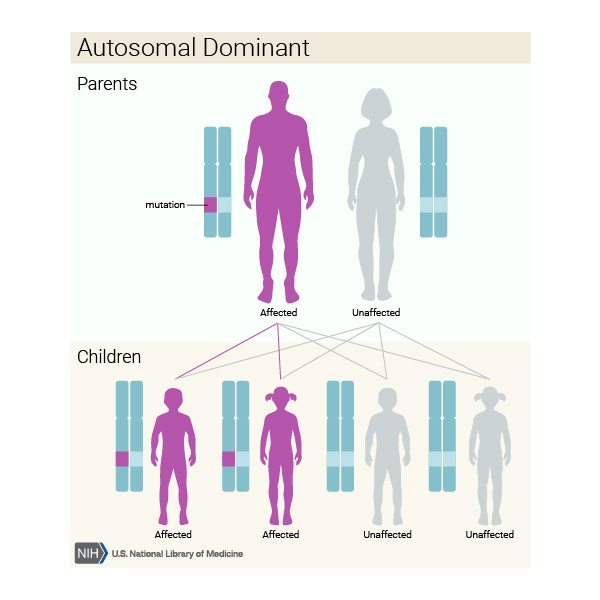Cystic Fibrosis
Cystic fibrosis (CF) is a serious illness that was incurable children’s disorder in the past (American Lung Association, n.d.). Modern treatment helps children with fibrosis live long lives. CF causes the development of thick mucus that damages the organs of the respiratory and digestive systems of the human body (Mohamed, 2020). This disease is characterized by the formation of cysts and fibrosis in patients’ lungs. CF is an inherited disorder that is caused by mutations in CFTR (cystic fibrosis transmembrane conductance regulator) gene (“Cystic fibrosis,” 2019). The CFTR gene controls fluid and salt flow in the human body, and when it does not function well, a thick mucus is generated.
If the child inherits mutated genes from both parents, the disease develops (“Cystic fibrosis,” 2019). If a child inherits one copy of the changed gene, the child has no symptoms but is a carrier of the disorder (see Table 1). C is a normal allele, and c is a mutated allele. If two parents of the child are CF carriers, the child would have a 50% chance to be a CF carrier (Cc). The child would have a 25% chance to have CF (cc) and a 25% chance to have no CF (CC) (“Determining genetic risk,” 2021).
Table 1. Punnett Square.
The uncommon facts about CF are as follows. CF is uncommon because about 30,000 Americans have this illness (Medline Plus, n.d.). One thousand new cases of CF are diagnosed every year (“Cystic fibrosis,” 2019). CF is more common in the white population of the USA (Medline Plus, n.d.). It is not common among African Americans (1 in 17,000 people). It is rare in Asian Americans (1 in 31,000 people) (Medline Plus, n.d.).
Polycystic Kidney Disease
Polycystic kidney disease (PKD) is a severe inherited disorder that may be caused by an issue with one’s genes (Mayo Clinic Staff, 2020). It is generally inherited from both parents or either of them, and PKD may occur in persons of all nationalities, ethnicities, races, ages, and genders (Medical Advisory Committee, 2020). Researchers also note that women and men are diagnosed with polycystic kidney disease equally as often (Medical Advisory Committee, 2020). This disease causes a number of fluid-filled cysts to appear in a persons’ kidneys, which results in an increase in their size and even loss of function over time (National Institute of Diabetes and Digestive and Kidney Diseases [NIDDK], 2017). According to Mayo Clinic Staff (2020), “cysts are noncancerous round sacs containing fluid” and may differ in their size (para. 1) (see Figure 1).

Signs and symptoms typically include kidney infections, urinary tract, kidney failure, kidney stones, headaches, increased abdomen size and a feeling of fullness in it, blood in urine, side or back pain, and high blood pressure (Mayo Clinic Staff, 2020). According to Torra (2020), in Europe and North America, autosomal dominant polycystic kidney disease, which is the most common type of PKD, is responsible for 6-10% of end-stage renal disease (ESRD) cases (see Figure 2).

Specific tests may help provide a diagnosis by assessing the amount of healthy kidney tissue and detecting cysts’ number and size. The first test is an ultrasound that can translate the reflected sound waves into kidneys’ images (Mayo Clinic Staff, 2020). Next, a CT scan may project X-ray beams through the patient’s body and allow the doctor to see the kidneys’ cross-sectional views (NIDDK, 2017). Finally, an MRI scan is when radio waves and magnetic fields provide cross-sectional images of damaged and healthy kidneys (Mayo Clinic Staff, 2020).
Typically, PKD treatment includes eliminating complications, symptoms, and signs. For instance, tolvaptan therapy can be suggested to prevent kidney cyst growth, and monitoring blood pressure with medications (angiotensin II receptor blockers or angiotensin-converting enzyme) may slow kidney damage (Medical Advisory Committee, 2020). Also, drinking more water and eating less protein may slow down kidney function decline. In case of kidney failure, a patient usually requires either a kidney transplant or dialysis (Mayo Clinic Staff, 2020).
For those diagnosed with PKD and consider having children, it is possible to have a genetic counselor assess the risk of passing this disorder to the offspring (Mayo Clinic Staff, 2020). To prevent PKD complications, namely, loss of kidney function, high blood pressure, chronic pain, and other severe symptoms, it is necessary to keep one’s kidneys as healthy as possible. Managing blood pressure is a way to protect the kidneys. To do that, it is recommended to limit alcohol use, quit smoking, exercise regularly, and maintain a healthy weight (“Polycystic kidney disease,” 2020). What is more, medics advise to stick to a low-salt diet, eat more whole grains, vegetables, and fruits, and take prescribed blood pressure medications (Mayo Clinic Staff, 2020)? These simple recommendations, many of which are also advised to healthy people, may help prevent complications.
The uncommon facts about PDK are the following. In the UK, polycystic kidney disease accounts for approximately one in eight persons with a kidney transplant and one in ten patients on dialysis (“Polycystic kidney disease,” 2020). It affects about 1 in 1000 people all over the world (Mayo Clinic Staff, 2020). Every year, there are more than 200,000 cases of PDK (Medical Advisory Committee, 2020). Approximately half of the persons over the age of fifty may develop polycystic kidney disease (Medical Advisory Committee, 2020). Men have an increased kidney failure risk (Mayo Clinic Staff, 2020).
References
American Lung Association. (n.d.). Cystic fibrosis (CF). Web.
Cystic fibrosis. (2019). WebMD. Web.
Determining genetic risk. (2021). KU Medical Center. Web.
Mayo Clinic Staff. (2020). Polycystic kidney disease. Mayo Clinic. Web.
Medical Advisory Committee. (2020). Polycystic kidney disease. American Kidney Fund. Web.
Medline Plus. (n.d.). Cystic fibrosis. Web.
Mohamed, A. W. (2020). Cystic fibrosis. Healthline. Web.
National Institute of Diabetes and Digestive and Kidney Diseases. (2017). What is polycystic kidney disease? NIDDK. Web.
Polycystic kidney disease. (2020). Medicine Plus. Web.
Torra, R. (2020). What is the prevalence of autosomal dominant polycystic kidney disease (ADPKD)? Medscape. Web.